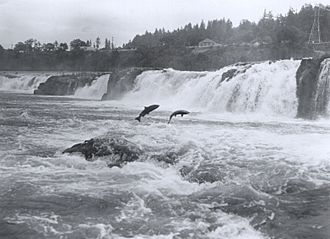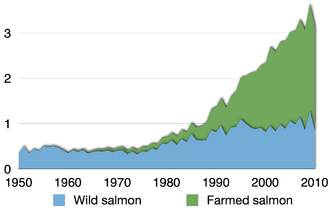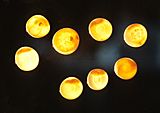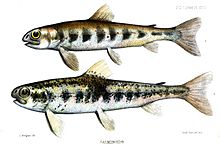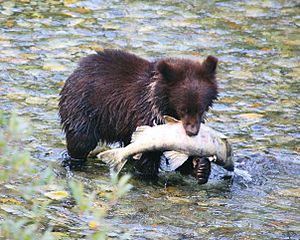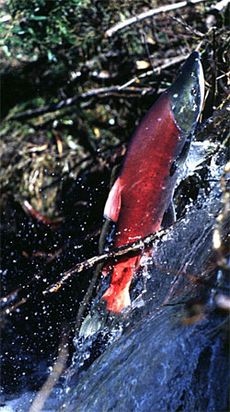Salmon facts for kids
Quick facts for kids Salmon |
|
|---|---|
 |
|
| Scientific classification | |
| Kingdom: | |
| Phylum: | |
| Order: | |
| Family: | |
| Subfamily: | |
Salmon is the common name for several species of ray-finned fish in the family Salmonidae. Other fish in the same family include trout, char, grayling and whitefish. Salmon are native to tributaries of the North Atlantic (genus Salmo) and Pacific Ocean (genus Oncorhynchus). Many species of salmon have been introduced into non-native environments such as the Great Lakes of North America and Patagonia in South America. Salmon are intensively farmed in many parts of the world.
Typically, salmon are anadromous: they hatch in fresh water, migrate to the ocean, then return to fresh water to reproduce. However, populations of several species are restricted to fresh water through their lives. Folklore has it that the fish return to the exact spot where they hatched to spawn. Tracking studies have shown this to be mostly true. A portion of a returning salmon run may stray and spawn in different freshwater systems; the percent of straying depends on the species of salmon. Homing behavior has been shown to depend on olfactory memory. Salmon date back to the Neogene.
Contents
Species
The term "salmon" comes from the Latin salmo, which in turn might have originated from salire, meaning "to leap". The nine commercially important species of salmon occur in two genera. The genus Salmo contains the Atlantic salmon, found in the north Atlantic, as well as many species commonly named trout. The genus Oncorhynchus contains eight species which occur naturally only in the North Pacific. As a group, these are known as Pacific salmon. Chinook salmon have been introduced in New Zealand and Patagonia. Coho, freshwater sockeye, and Atlantic salmon have been established in Patagonia, as well.
| Atlantic and Pacific salmon | ||||||||||||
|---|---|---|---|---|---|---|---|---|---|---|---|---|
| Genus | Image | Common name | Scientific name | Maximum length |
Common length |
Maximum weight |
Maximum age |
Trophic level |
Fish Base |
FAO | ITIS | IUCN status |
| Salmo (Atlantic salmon) |
 |
Atlantic salmon | Salmo salar Linnaeus, 1758 | 150 cm | 120 cm | 46.8 kg | 13 years | 4.4 | ||||
| Oncorhynchus (Pacific salmon) |
 |
Chinook salmon | Oncorhynchus tshawytscha (Walbaum, 1792) | 150 cm | 70 cm | 61.4 kg | 9 years | 4.4 | Not assessed | |||
 |
Chum salmon | Oncorhynchus keta (Walbaum, 1792) | 100 cm | 58 cm | 15.9 kg | 7 years | 3.5 | Not assessed | ||||
 |
Coho salmon | Oncorhynchus kisutch (Walbaum, 1792) | 108 cm | 71 cm | 15.2 kg | 5 years | 4.2 | Not assessed | ||||
 |
Masu salmon | Oncorhynchus masou (Brevoort, 1856) | 79 cm | cm | 10.0 kg | 3 years | 3.6 | Not assessed | ||||
 |
Pink salmon | Oncorhynchus gorbuscha (Walbaum, 1792) | 76 cm | 50 cm | 6.8 kg | 3 years | 4.2 | Not assessed | ||||
 |
Sockeye salmon | Oncorhynchus nerka (Walbaum, 1792) | 84 cm | 58 cm | 7.7 kg | 8 years | 3.7 | |||||
† Both the Salmo and Oncorhynchus genera also contain a number of species referred to as trout. Within Salmo, additional minor taxa have been called salmon in English, i.e. the Adriatic salmon (Salmo obtusirostris) and Black Sea salmon (Salmo labrax). The steelhead anadromous form of the rainbow trout migrates to sea, but it is not termed "salmon".
Also there are a number of other species which are not true salmon, as in the above list, but have common names which refer to them as being salmon. Of those listed below, the Danube salmon or huchen is a large freshwater salmonid related to the salmon above, but others are marine fishes of the unrelated Perciformes order:
| Some other fishes called salmon | ||||||||||
|---|---|---|---|---|---|---|---|---|---|---|
| Common name | Scientific name | Maximum length |
Common length |
Maximum weight |
Maximum age |
Trophic level |
Fish Base |
FAO | ITIS | IUCN status |
| Australian salmon | Arripis trutta (Forster, 1801) | 89 cm | 47 cm | 9.4 kg | 26 years | 4.1 | Not assessed | |||
| Danube salmon | Hucho hucho (Linnaeus, 1758) | 150 cm | 70 cm | 52 kg | 15 years | 4.2 | ||||
| Hawaiian salmon | Elagatis bipinnulata (Quoy & Gaimard, 1825) | 180 cm | 90 cm | 46.2 kg | years | 3.6 | Not assessed | |||
| Indian salmon | Eleutheronema tetradactylum (Shaw, 1804) | 200 cm | 50 cm | 145 kg | years | 4.4 | Not assessed | |||
Eosalmo driftwoodensis, the oldest known salmon in the fossil record, helps scientists figure how the different species of salmon diverged from a common ancestor. The British Columbia salmon fossil provides evidence that the divergence between Pacific and Atlantic salmon had not yet occurred 40 million years ago. Both the fossil record and analysis of mitochondrial DNA suggest the divergence occurred by 10 to 20 million years ago. This independent evidence from DNA analysis and the fossil record indicate that salmon divergence occurred long before the glaciers (of Quaternary glaciation) began their cycle of advance and retreat.
Distribution
- Atlantic salmon (Salmo salar) reproduce in northern rivers on both coasts of the Atlantic Ocean.
- Landlocked salmon (Salmo salar m. sebago) live in a number of lakes in eastern North America and in Northern Europe, for instance in lakes Sebago, Onega, Ladoga, Saimaa, Vänern, and Winnipesaukee. They are not a different species from the Atlantic salmon, but have independently evolved a non-migratory life cycle, which they maintain even when they could access the ocean.
- Chinook salmon (Oncorhynchus tshawytscha) are also known in the United States as king salmon or blackmouth salmon, and as spring salmon in British Columbia. Chinook are the largest of all Pacific salmon, frequently exceeding 14 kg (30 lb). The name tyee is used in British Columbia to refer to Chinook over 30 pounds, and in the Columbia River watershed, especially large Chinook were once referred to as June hogs. Chinook salmon are known to range as far north as the Mackenzie River and Kugluktuk in the central Canadian arctic, and as far south as the Central California coast.
- Chum salmon (Oncorhynchus keta) are known as dog, keta, or calico salmon in some parts of the US. This species has the widest geographic range of the Pacific species: in the eastern Pacific from north of the Mackenzie River in Canada to south of the Sacramento River in California and in the western Pacific from Lena River in Siberia to the island of Kyūshū in the Sea of Japan.
- Coho salmon (Oncorhynchus kisutch) are also known in the US as silver salmon. This species is found throughout the coastal waters of Alaska and British Columbia and as far south as Central California (Monterey Bay). It is also now known to occur, albeit infrequently, in the Mackenzie River.
- Masu salmon or cherry salmon (Oncorhynchus masou) are found only in the western Pacific Ocean in Japan, Korea, and Russia. A land-locked subspecies known as the Taiwanese salmon or Formosan salmon (Oncorhynchus masou formosanus) is found in central Taiwan's Chi Chia Wan Stream.
- Pink salmon (Oncorhynchus gorbuscha), known as humpies in southeast and southwest Alaska, are found in the western Pacific from Lena River in Siberia to Korea, found throughout northern Pacific, and in the eastern Pacific from the Mackenzie River in Canada to northern California, usually in shorter coastal streams. It is the smallest of the Pacific species, with an average weight of 1.6 to 1.8 kg (3.5 to 4.0 lb).
- Sockeye salmon (Oncorhynchus nerka) are also known in the US as red salmon. This lake-rearing species is found in the eastern Pacific from Bathurst Inlet in the Canadian Arctic to Klamath River in California, and in the western Pacific from the Anadyr River in Siberia to northern Hokkaidō island in Japan. Although most adult Pacific salmon feed on small fish, shrimp, and squid, sockeye feed on plankton they filter through gill rakers. Kokanee salmon are the land-locked form of sockeye salmon.
- Danube salmon, or huchen (Hucho hucho), are the largest permanent freshwater salmonid species.
Life cycle
Salmon eggs are laid in freshwater streams typically at high latitudes. The eggs hatch into alevin or sac fry. The fry quickly develop into parr with camouflaging vertical stripes. The parr stay for six months to three years in their natal stream before becoming smolts, which are distinguished by their bright, silvery colour with scales that are easily rubbed off. Only 10% of all salmon eggs are estimated to survive to this stage.
The smolt body chemistry changes, allowing them to live in salt water. While a few species of salmon remain in fresh water throughout their life cycle, the majority are anadromous and migrate to the ocean for maturation: in these species, smolts spend a portion of their out-migration time in brackish water, where their body chemistry becomes accustomed to osmoregulation in the ocean.
The salmon spend about one to five years (depending on the species) in the open ocean, where they gradually become sexually mature. The adult salmon then return primarily to their natal streams to spawn. Atlantic salmon spend between one and four years at sea. When a fish returns after just one year's sea feeding, it is called a grilse in Canada, Britain, and Ireland. Grilse may be present at spawning, and go unnoticed by large males, releasing their own sperm on the eggs.
Prior to spawning, depending on the species, salmon undergo changes. They may grow a hump, develop canine-like teeth, or develop a kype (a pronounced curvature of the jaws in male salmon). All change from the silvery blue of a fresh-run fish from the sea to a darker colour. Salmon can make amazing journeys, sometimes moving hundreds of miles upstream against strong currents and rapids to reproduce. Chinook and sockeye salmon from central Idaho, for example, travel over 1,400 km (900 mi) and climb nearly 2,100 m (7,000 ft) from the Pacific Ocean as they return to spawn. Condition tends to deteriorate the longer the fish remain in fresh water, and they then deteriorate further after they spawn, when they are known as kelts. In all species of Pacific salmon, the mature individuals die within a few days or weeks of spawning, a trait known as semelparity. Between 2 and 4% of Atlantic salmon kelts survive to spawn again, all females. However, even in those species of salmon that may survive to spawn more than once (iteroparity), postspawning mortality is quite high (perhaps as high as 40 to 50%).
To lay her roe, the female salmon uses her tail (caudal fin), to create a low-pressure zone, lifting gravel to be swept downstream, excavating a shallow depression, called a redd. The redd may sometimes contain 5,000 eggs covering 2.8 m2 (30 sq ft). The eggs usually range from orange to red. One or more males approach the female in her redd, depositing sperm, or milt, over the roe. The female then covers the eggs by disturbing the gravel at the upstream edge of the depression before moving on to make another redd. The female may make as many as seven redds before her supply of eggs is exhausted.
Each year, the fish experiences a period of rapid growth, often in summer, and one of slower growth, normally in winter. This results in ring formation around an earbone called the otolith (annuli), analogous to the growth rings visible in a tree trunk. Freshwater growth shows as densely crowded rings, sea growth as widely spaced rings; spawning is marked by significant erosion as body mass is converted into eggs and milt.
Freshwater streams and estuaries provide important habitat for many salmon species. They feed on terrestrial and aquatic insects, amphipods, and other crustaceans while young, and primarily on other fish when older. Eggs are laid in deeper water with larger gravel, and need cool water and good water flow (to supply oxygen) to the developing embryos. Mortality of salmon in the early life stages is usually high due to natural predation and human-induced changes in habitat, such as siltation, high water temperatures, low oxygen concentration, loss of stream cover, and reductions in river flow. Estuaries and their associated wetlands provide vital nursery areas for the salmon prior to their departure to the open ocean. Wetlands not only help buffer the estuary from silt and pollutants, but also provide important feeding and hiding areas.
Salmon not killed by other means show greatly accelerated deterioration (phenoptosis, or "programmed aging") at the end of their lives. Their bodies rapidly deteriorate right after they spawn as a result of the release of massive amounts of corticosteroids.
Ecology
Bears and salmon
In the Pacific Northwest and Alaska, salmon are keystone species, supporting wildlife such as birds, bears and otters. The bodies of salmon represent a transfer of nutrients from the ocean, rich in nitrogen, sulfur, carbon and phosphorus, to the forest ecosystem.
Grizzly bears function as ecosystem engineers, capturing salmon and carrying them into adjacent wooded areas. There they deposit nutrient-rich urine and feces and partially eaten carcasses. Bears are estimated to leave up to half the salmon they harvest on the forest floor, in densities that can reach 4,000 kilograms per hectare, providing as much as 24% of the total nitrogen available to the riparian woodlands. The foliage of spruce trees up to 500 m (1,600 ft) from a stream where grizzlies fish salmon have been found to contain nitrogen originating from fished salmon.
Beavers and salmon
Beavers also function as ecosystem engineers; in the process of clear-cutting and damming, beavers alter their ecosystems extensively. Beaver ponds can provide critical habitat for juvenile salmon. An example of this was seen in the years following 1818 in the Columbia River Basin.
In 1818, the British government made an agreement with the U.S. government to allow U.S. citizens access to the Columbia catchment (see Treaty of 1818). At the time, the Hudson's Bay Company sent word to trappers to extirpate all furbearers from the area in an effort to make the area less attractive to U.S. fur traders. In response to the elimination of beavers from large parts of the river system, salmon runs plummeted, even in the absence of many of the factors usually associated with the demise of salmon runs. Salmon recruitment can be affected by beavers' dams because dams can:
- Slow the rate at which nutrients are flushed from the system; nutrients provided by adult salmon dying throughout the fall and winter remain available in the spring to newly hatched juveniles
- Provide deeper water pools where young salmon can avoid avian predators
- Increase productivity through photosynthesis and by enhancing the conversion efficiency of the cellulose-powered detritus cycle
- Create slow-water environments where juvenile salmon put the food they ingest into growth rather than into fighting currents
- Increase structural complexity with many physical niches where salmon can avoid predators
Beavers' dams are able to nurture salmon juveniles in estuarine tidal marshes where the salinity is less than 10 ppm. Beavers build small dams of generally less than 60 cm (2 ft) high in channels in the myrtle zone. These dams can be overtopped at high tide and hold water at low tide. This provides refuges for juvenile salmon so they do not have to swim into large channels where they are subject to predation.
Lampreys and salmon
It has been discovered that rivers which have seen a decline or disappearance of anadromous lampreys, loss of the lampreys also affects the salmon in a negative way. Like salmon, anadromous lampreys stop feeding and die after spawning, and their decomposing bodies release nutrients into the stream. Also, along with species like rainbow trout and Sacramento sucker, lampreys clean the gravel in the rivers during spawning. Their larvae, called ammocoetes, are filter feeders which contribute to the health of the waters. They are also a food source for the young salmon, and being fattier and oilier, it is assumed predators prefer them over salmon offspring, taking off some of the predation pressure on smolts. Adult lampreys are also the preferred prey of seals and sea lions, which can eat 30 lampreys to every salmon, allowing more adult salmon to enter the rivers to spawn without being eaten by the marine mammals.
As food
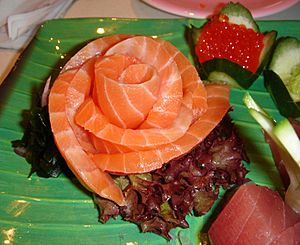
Salmon is a popular food. Classified as an oily fish, salmon is considered to be healthy due to the fish's high protein, high omega-3 fatty acids, and high vitamin D content. Salmon is also a source of cholesterol, with a range of 23–214 mg/100 g depending on the species. According to reports in the journal Science, farmed salmon may contain high levels of dioxins. PCB (polychlorinated biphenyl) levels may be up to eight times higher in farmed salmon than in wild salmon, but still well below levels considered dangerous. Nonetheless, according to a 2006 study published in the Journal of the American Medical Association, the benefits of eating even farmed salmon still outweigh any risks imposed by contaminants. Farmed salmon has a high omega 3 fatty acid content comparable to wild salmon. The type of omega-3 present may not be a factor for other important health functions.
Salmon flesh is generally orange to red, although white-fleshed wild salmon with white-black skin colour occurs. The natural colour of salmon results from carotenoid pigments, largely astaxanthin, but also canthaxanthin, in the flesh. Wild salmon get these carotenoids from eating krill and other tiny shellfish.
The vast majority of Atlantic salmon available around the world are farmed (almost 99%), whereas the majority of Pacific salmon are wild-caught (greater than 80%). Canned salmon in the US is usually wild Pacific catch, though some farmed salmon is available in canned form. Smoked salmon is another popular preparation method, and can either be hot or cold smoked. Lox can refer to either cold-smoked salmon or salmon cured in a brine solution (also called gravlax). Traditional canned salmon includes some skin (which is harmless) and bone (which adds calcium). Skinless and boneless canned salmon is also available.
Raw salmon flesh may contain Anisakis nematodes, marine parasites that cause anisakiasis. Before the availability of refrigeration, the Japanese did not consume raw salmon. Salmon and salmon roe have only recently come into use in making sashimi (raw fish) and sushi.
To the Indigenous peoples of the Pacific Northwest Coast, salmon is considered a vital part of the diet. Specifically, the indigenous peoples of Haida Gwaii, located near former Queen Charlotte Island in British Columbia, rely on salmon as one of their main sources of food, although many other bands have fished Pacific waters for centuries. Salmon are not only ancient and unique, but it is important because it is expressed in culture, art forms, and ceremonial feasts. Annually, salmon spawn in Haida, feeding on everything on the way upstream and down. Within the Haida nation, salmon is referred to as "tsiin", and is prepared in several ways including smoking, baking, frying, and making soup.
Historically, there has always been enough salmon, as people would not overfish, and only took what they needed. In 2003, a report on First Nation participation in commercial fisheries, including salmon, commissioned by BC's Ministry of Agriculture, Food and Fisheries found that there were 595 First Nation-owned and operated commercial vessels in the province. Of those vessels, First Nations’ members owned 564. However, employment within the industry has decreased overall by 50% in the last decade, with 8,142 registered commercial fishermen in 2003. This has affected employment for many fisherman, who rely on salmon as a source of income.
Black bears also rely on salmon as food. The leftovers the bears leave behind are considered important nutrients for the Canadian forest, such as the soil, trees, and plants. In this sense, the salmon feed the forest and in return receive clean water and gravel in which to hatch and grow, sheltered from extremes of temperature and water flow in times of high and low rainfall. However, the condition of the salmon in Haida has been affected in recent decades. Due to logging and development, much of the salmon's habitat (i.e., Ain River) has been destroyed, resulting in the fish being close to endangered. For residents, this has resulted in limits on catches, in turn, has affected families diets, and cultural events such as feasts. Some of the salmon systems in danger include: the Davidon, Naden, Mamim, and Mathers. It is clear that further protection is needed for salmon, such as their habitats, where logging commonly occurs.
Images for kids
-
Henneguya salminicola, a myxozoan parasite commonly found in the flesh of salmonids on the West Coast of Canada, in coho salmon
-
Wild fisheries – commercial capture in tonnes of all true wild salmon species 1950–2010, as reported by the FAO
-
Aquaculture production in tonnes of all true salmon species 1950–2010, as reported by the FAO
-
Spawning sockeye salmon in Becharof Creek, Becharof Wilderness, Alaska
-
Scales on the "Big Fish" or "Salmon of Knowledge" celebrates the return of fish to the River Lagan
See also
 In Spanish: Salmones y truchas para niños
In Spanish: Salmones y truchas para niños


